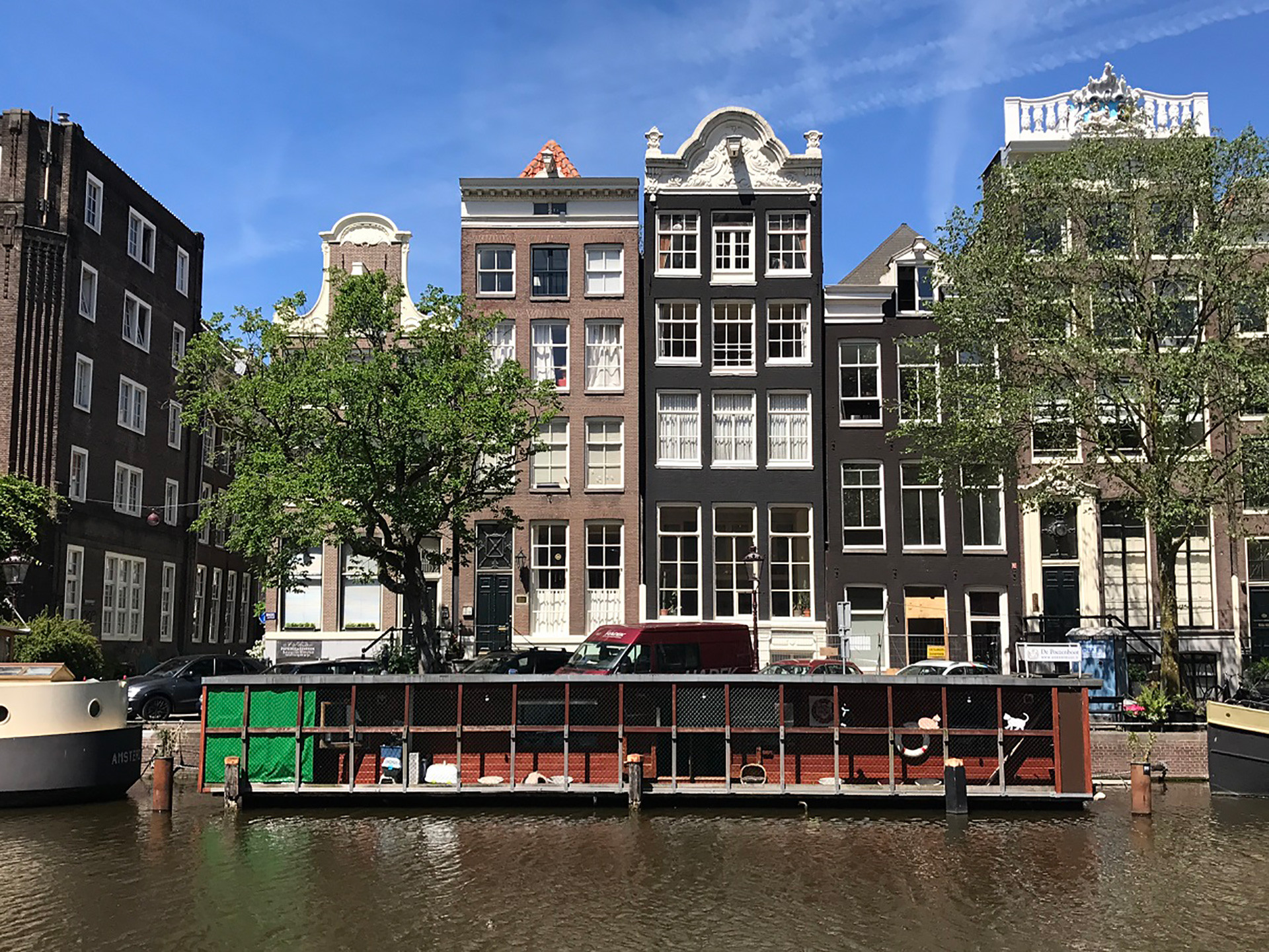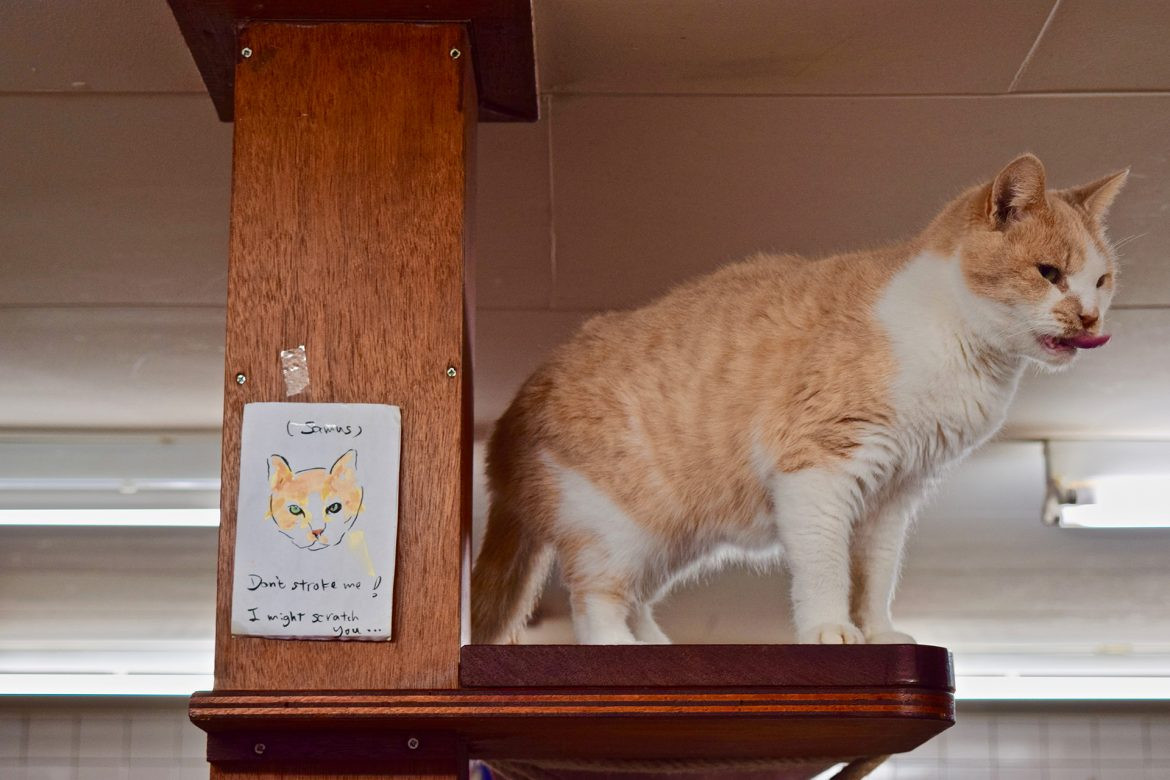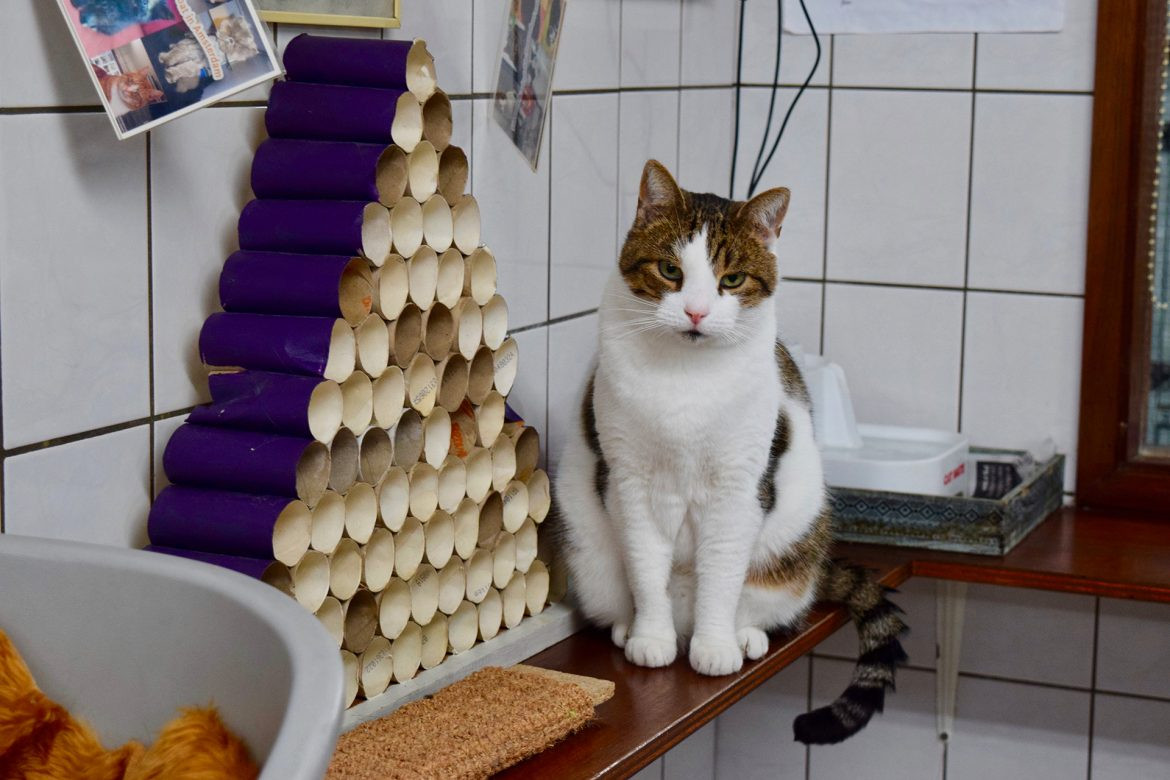De Poezenboot Photos capture the unique charm and heartwarming mission of this Amsterdam cat sanctuary, and dfphoto.net celebrates this intersection of photography and feline welfare. Our article will delve into the appeal of these images, explore the story behind the floating haven, and offer tips for capturing similar heartwarming moments through your lens. Explore the photogenic world of cat photography and animal rescue with these inspiring photos.
1. What is De Poezenboot?
De Poezenboot, or “The Catboat” in Dutch, is a unique animal shelter in Amsterdam. It’s a floating sanctuary dedicated to rescuing and rehoming stray and abandoned cats. This organization has been around since 1968, offering a safe haven for felines in need. The Poezenboot is a houseboat where cats can roam freely, receive care, and wait for their forever homes. According to the official website, De Poezenboot relies entirely on donations and volunteers to operate, highlighting its community-driven spirit.
2. Why are De Poezenboot Photos so Popular?
The popularity of De Poezenboot photos stems from several factors. First, the cats themselves are undeniably adorable. Their playful antics and unique personalities shine through in the images. Second, the setting is charming. The floating sanctuary provides a quirky and visually appealing backdrop. Third, the story behind De Poezenboot resonates with animal lovers. The photos capture the compassion and dedication of the volunteers who care for the cats.
2.1. The Adorable Factor
Cats have always been popular subjects for photography, and De Poezenboot is no exception. The photos often capture the cats in endearing poses, showcasing their playful and curious nature. The diverse personalities of the cats, from cuddly kittens to mischievous adults, ensure that there is something to appeal to everyone.
2.2. The Unique Setting
The fact that De Poezenboot is a floating sanctuary adds to its allure. The canal setting provides a picturesque backdrop, creating a visually interesting contrast between the cats and the urban environment. The novelty of a cat shelter on a boat also makes the photos stand out.
 De Poezenboot's serene location on the Amsterdam canal
De Poezenboot's serene location on the Amsterdam canal
2.3. The Heartwarming Story
The story of De Poezenboot is one of compassion and dedication. The photos often depict the volunteers caring for the cats, highlighting the bond between humans and animals. This heartwarming narrative adds an emotional depth to the images, making them even more appealing.
3. What Kind of Photography Can You Find at De Poezenboot?
De Poezenboot photos encompass a variety of photographic styles. You’ll find portraits showcasing the individual personalities of the cats, candid shots capturing their daily activities, and environmental portraits that highlight the unique setting of the floating sanctuary. The images often blend documentary and artistic elements, offering a glimpse into the lives of the cats and the people who care for them.
3.1. Cat Portraits
Portraits are a popular genre in De Poezenboot photography. These images aim to capture the unique characteristics of each cat, showcasing their individual personalities and expressions.
3.2. Candid Photography
Candid shots capture the cats in their natural environment, going about their daily activities. These images offer a glimpse into the lives of the cats, showcasing their playful antics and interactions with each other.
3.3. Environmental Portraits
Environmental portraits combine elements of portraiture and landscape photography. These images showcase the cats in their environment, highlighting the unique setting of De Poezenboot and its relationship to the surrounding canal.
4. What Photography Techniques Are Used in De Poezenboot Photos?
Several photography techniques are commonly used in De Poezenboot photos. These include using natural light to capture the cats’ beauty, employing shallow depth of field to isolate the subject and create a sense of intimacy, and composing shots to highlight the unique setting and create visual interest. The photographers often use a combination of these techniques to create compelling and heartwarming images.
4.1. Utilizing Natural Light
Natural light is a key element in De Poezenboot photography. The photographers often take advantage of the soft, diffused light that filters through the windows of the boat to capture the cats’ beauty. This type of lighting is flattering and helps to create a warm and inviting atmosphere.
4.2. Shallow Depth of Field
Shallow depth of field is a technique that isolates the subject from the background, creating a sense of intimacy and drawing the viewer’s attention to the cat’s features. This technique is often used in portraits to create a soft and dreamy effect.
4.3. Composition Techniques
Composition is an important aspect of De Poezenboot photography. The photographers often use techniques such as the rule of thirds, leading lines, and symmetry to create visually appealing and balanced images. They also pay attention to the background, ensuring that it complements the subject and adds to the overall story.
5. What Equipment is Recommended for Photographing Cats?
Photographing cats, especially in a dynamic environment like De Poezenboot, requires certain equipment to capture those purr-fect moments. A versatile camera with a fast lens is crucial, along with accessories that aid in capturing sharp and well-lit images. Here’s a breakdown of recommended equipment:
| Equipment | Recommendation |
|---|---|
| Camera | DSLR or Mirrorless: Offers interchangeable lenses and better low-light performance. Models like the Nikon D7500 or Sony Alpha series (e.g., a6400 or a7 III) are excellent choices. |
| Lens | Fast Prime Lens (e.g., 50mm f/1.8 or 35mm f/1.8): Essential for low-light conditions and creating a shallow depth of field to isolate the cat. |
| Zoom Lens (e.g., 24-70mm f/2.8 or 70-200mm f/2.8): Provides flexibility in framing shots from different distances. Ideal for capturing candid moments without disturbing the cats. | |
| Flash | External Flash with Diffuser: Useful for filling in shadows and adding light when natural light is insufficient. A diffuser softens the light, preventing harsh reflections on the cats’ fur. |
| Tripod | Lightweight Tripod: Helps stabilize the camera in low-light conditions or when using longer shutter speeds, ensuring sharp images. |
| Accessories | Memory Cards: High-capacity and fast memory cards to store numerous high-resolution images. |
| Extra Batteries: Essential for long shooting sessions, ensuring you don’t miss any precious moments. | |
| Camera Bag: To protect and carry your equipment comfortably. | |
| Editing Software | Adobe Lightroom or Capture One: For post-processing adjustments such as exposure, contrast, and color correction. |
6. How Can I Improve My Cat Photography?
Improving your cat photography involves understanding feline behavior, mastering camera settings, and being patient. Here are some tips to enhance your skills:
6.1. Understand Cat Behavior
Cats are naturally curious and active, but they can also be easily spooked. Understanding their behavior helps in predicting their actions and capturing genuine moments. Spend time observing the cats to learn their habits and preferences.
6.2. Master Camera Settings
Using the right camera settings is crucial for capturing sharp and well-exposed images. Here are some settings to consider:
- Aperture: Use a wide aperture (e.g., f/1.8 or f/2.8) for shallow depth of field and to let in more light in low-light conditions.
- Shutter Speed: Use a fast shutter speed (e.g., 1/200s or faster) to freeze the motion of active cats.
- ISO: Adjust the ISO to balance brightness and noise. Keep it as low as possible while maintaining a good exposure.
- Focus Mode: Use continuous autofocus (AF-C) to track moving cats and ensure they stay in focus.
6.3. Use Natural Light
Natural light is often the most flattering for cat photography. Avoid using direct flash, as it can create harsh shadows and red-eye. Instead, try to photograph the cats near windows or in soft, diffused light.
6.4. Get Down to Their Level
Getting down to the cat’s level can create a more intimate and engaging perspective. It also helps to capture their expressions and features more effectively.
6.5. Be Patient
Cats are unpredictable, so patience is key. Be prepared to wait for the right moment to capture the perfect shot. Carry treats or toys to help coax them into the desired pose or position.
 Photographing cats requires patience and getting down to their level
Photographing cats requires patience and getting down to their level
7. What are Some Ethical Considerations in Animal Photography?
Ethical animal photography prioritizes the well-being and safety of the animals above all else. It’s essential to respect their space and avoid causing them stress or harm. Here are some ethical considerations to keep in mind:
7.1. Avoid Causing Stress
Be mindful of the animals’ behavior and avoid any actions that might cause them stress or anxiety. This includes loud noises, sudden movements, and invasive lighting.
7.2. Respect Their Space
Give the animals plenty of space and avoid crowding them. Respect their boundaries and allow them to approach you on their own terms.
7.3. Do Not Use Baiting or Luring
Avoid using baiting or luring techniques that might endanger the animals or disrupt their natural behavior. This includes using food or other attractants to force them into a particular pose or position.
7.4. Obtain Permission
If you are photographing animals in a sanctuary or rescue organization, obtain permission from the staff and follow their guidelines. This ensures that you are respecting their rules and contributing to the well-being of the animals.
7.5. Represent Animals Honestly
Avoid manipulating images in a way that misrepresents the animals or their environment. This includes adding or removing elements, altering colors, or creating false narratives.
8. How Does De Poezenboot Support Cat Welfare?
De Poezenboot is dedicated to supporting cat welfare through various initiatives. The organization provides shelter and care for stray and abandoned cats, facilitates adoptions, and promotes responsible pet ownership. They also offer spaying and neutering services to help control the cat population.
8.1. Providing Shelter and Care
De Poezenboot provides a safe and comfortable environment for cats in need. The shelter offers food, water, medical care, and socialization to help the cats thrive.
8.2. Facilitating Adoptions
De Poezenboot works to find loving homes for the cats in their care. They carefully screen potential adopters to ensure that the cats are placed in suitable environments.
8.3. Promoting Responsible Pet Ownership
De Poezenboot promotes responsible pet ownership through education and outreach programs. They provide information on cat care, nutrition, and behavior to help owners provide the best possible care for their feline companions.
8.4. Offering Spaying and Neutering Services
De Poezenboot offers spaying and neutering services to help control the cat population and prevent unwanted litters. This is an important step in reducing the number of stray and abandoned cats. According to a study by the American Society for the Prevention of Cruelty to Animals (ASPCA), spaying or neutering your cat can also improve their health and behavior.
9. What is the Impact of Photography on Animal Welfare?
Photography can have a significant impact on animal welfare. Images can raise awareness about animal issues, inspire action, and promote positive change. They can also be used to document animal abuse and neglect, providing evidence for legal action.
9.1. Raising Awareness
Photographs can capture the beauty and vulnerability of animals, raising awareness about their needs and challenges. They can also be used to educate the public about animal welfare issues, such as habitat loss, poaching, and animal cruelty.
9.2. Inspiring Action
Compelling images can inspire people to take action to protect animals. They can motivate individuals to donate to animal welfare organizations, volunteer their time, and advocate for stronger animal protection laws.
9.3. Promoting Positive Change
Photographs can be used to promote positive change in animal welfare. They can showcase successful conservation efforts, highlight the benefits of responsible pet ownership, and celebrate the bond between humans and animals.
10. How Can I Support De Poezenboot?
There are several ways to support De Poezenboot and their mission to help cats in need. You can donate to the organization, volunteer your time, or adopt a cat. You can also help by spreading the word about De Poezenboot and their work.
10.1. Donating to the Organization
De Poezenboot relies on donations to provide shelter, care, and medical treatment for the cats. Your financial support can make a big difference in the lives of these animals.
10.2. Volunteering Your Time
De Poezenboot is always looking for volunteers to help with various tasks, such as feeding, cleaning, and socializing the cats. Volunteering your time is a rewarding way to contribute to the organization.
10.3. Adopting a Cat
If you are looking for a feline companion, consider adopting a cat from De Poezenboot. You’ll be giving a deserving animal a loving home and helping to make room for other cats in need.
 Cats at De Poezenboot are waiting for loving homes
Cats at De Poezenboot are waiting for loving homes
10.4. Spreading the Word
You can help De Poezenboot by spreading the word about their work. Share their photos and stories on social media, tell your friends and family about the organization, and encourage others to support their mission.
Visiting De Poezenboot in person offers a unique opportunity to witness their inspiring work firsthand. Located at Sigel 38G, Amsterdam, Netherlands, it’s easily accessible for those wanting to experience the sanctuary’s charm. If a visit isn’t possible, explore their website at depoezenboot.nl/en to learn more about their mission and ways to contribute. For direct inquiries, you can reach them via phone. De Poezenboot is not just a haven for cats; it’s a symbol of compassion and dedication in the heart of Amsterdam.
FAQ about De Poezenboot Photos
1. What is De Poezenboot?
De Poezenboot is a floating cat sanctuary in Amsterdam dedicated to rescuing and rehoming stray and abandoned cats.
2. Why are De Poezenboot photos so popular?
The photos are popular due to the adorable cats, unique setting, and heartwarming story behind the sanctuary.
3. What kind of photography can you find at De Poezenboot?
You can find cat portraits, candid shots, and environmental portraits showcasing the cats and their surroundings.
4. What photography techniques are used in De Poezenboot photos?
Common techniques include using natural light, shallow depth of field, and thoughtful composition.
5. What equipment is recommended for photographing cats?
A DSLR or mirrorless camera with a fast lens, external flash, and tripod are recommended.
6. How can I improve my cat photography?
Understand cat behavior, master camera settings, use natural light, and be patient.
7. What are some ethical considerations in animal photography?
Avoid causing stress, respect their space, and do not use baiting or luring techniques.
8. How does De Poezenboot support cat welfare?
De Poezenboot provides shelter, facilitates adoptions, promotes responsible pet ownership, and offers spaying and neutering services.
9. What is the impact of photography on animal welfare?
Photography can raise awareness, inspire action, and promote positive change in animal welfare.
10. How can I support De Poezenboot?
You can donate, volunteer your time, adopt a cat, or spread the word about their work.
De Poezenboot photos are not just images; they are a window into a world of compassion and dedication. By understanding the techniques and stories behind these photos, you can appreciate the beauty and importance of animal photography. Visit dfphoto.net for more inspiration and tips on capturing heartwarming moments through your lens.